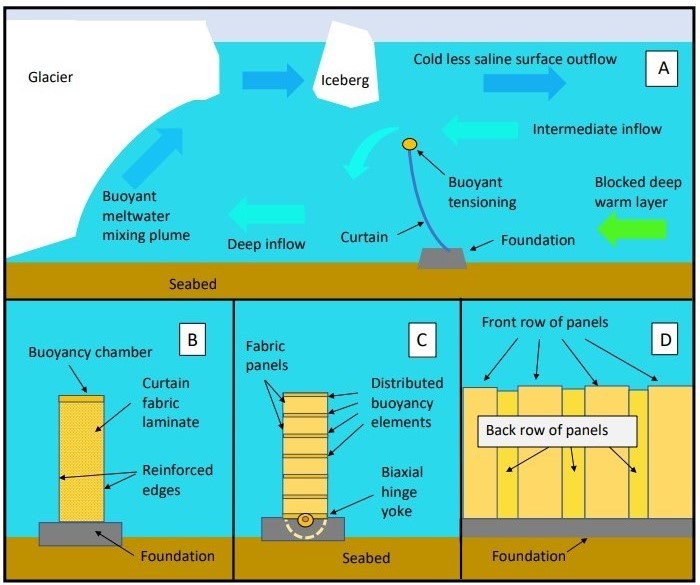Icebergs at the mouth of the Ilulissat Icefjord in Greenland, close to where the curtains could be placed. Photo: Nico Vera-Ortiz
As the climate changes, more and more warm seawater reaches the glaciers of Antarctica and threatens them to collapse. A group of researchers explores how feasible the idea is to block channels that bring warm water to the glaciers with flexible buoyant curtains, anchored to the seabed. Their study has now been published in the open access journal PNAS Nexus.
The possible collapse of the West Antarctic Ice Sheet is one of the most dramatic impacts of climate warming. Currently, floating ice shelves hold the ice sheet in place. But the Thwaites and Pine Island Glaciers in Antarctica are rapidly thinning and retreating as deep salty seawater warmed by climate change licks at the undersides of their leading edges.
– Once started, and there is evidence that it has already, a collapse cannot be stopped by reducing greenhouse gas emissions, says John Moore, researcher at the Arctic Centre at the University of Lapland in Rovaniemi and the Beijing Normal University in China.
– The sea level will rise several meters over the next few centuries and force the largest migration in human history away from the coasts, Moore adds. Given the slow and limited response of sea level to emissions control, Moore and his team came up with an alternative method to stabilize the ice sheets.
Naturally, the waters around Antarctica have an upper layer of relatively cold and fresher water on top of a warmer, higher salinity layer beneath. Moore and his colleagues examine how to physically block the warm water from reaching Antarctica. The way to do it: partially blocking deep seabed channels that guide warm seawater.
– A couple of us glaciologists independently noticed how seabed sills and high points naturally keep warm waters away from the ice edge, so it seemed natural to raise the sea floor. Then Bowie Keefer, an engineer from Canada, told us much cleverer ways to do it by using curtains, Moore explains.
The curtains would be around 100 meters high, deployed as many in narrow sections, so that they block the stream in the lower layer but allow the outflow of nutrient-rich waters from the glaciers. Additionally, the curtains need to be flexible so that icebergs push them aside as they move past, rather than destroy them.
With warm water access reduced, the ice would thicken and reground on the seafloor to securely support the vulnerable parts of the West Antarctica ice sheet. The authors estimate that the installation of these curtains would cost 40 to 80 billion dollars and requires one to two billion dollars per year in maintenance.
– This might sound like a lot of money but doing nothing would be far more expensive. By 2100, building and maintaining coastal protection is expected to cost around 40 billion dollars per year for every meter of sea level rise, and such adaptation is far harder for the Developing World than in the wealthy countries that have caused global heating, Moore points out.

Seabed curtain schematic (not to scale). A) Exchange flow over the curtain. Front view of a single curtain panel with buoyancy concentrated at the top, B), or distributed along the height (C) showing how the curtain panels could be pivoted to allow transverse sway. Sets of panels (D) joined to make a long curtain with overlapping front and back rows to accommodate locally varying forces.
Studies in Greenland could provide important insights
Before the method can be applied to Antarctica, there is much research to be done: on governance, ecology, engineering, and glacier oceanography. An 80 km long Antarctic curtain would be the most challenging engineering project ever attempted. So, engineers and oceanographers have much to learn in more accessible places. Moore and his team are exploring if shorter curtains in key Greenland fjords make any sense. The Greenland ice sheet faces the same problem as Antarctica but is already much warmer, and fishing and hunting ways of life are rapidly changing.
– Greenlanders we work with find some positives in the intervention idea - it empowers local peoples and raises global awareness of their stewardship of this vital global good. But any intervention must be done as a co-design with local people in the Arctic – it’s their choice in the end, and must benefit them as well as the globe, Moore says.
In October 2022, Moore and his colleagues were able to discuss their ideas at a meeting in Reykjavik with several rightsholders as well as engineering companies and leading scientists in several fields.
– These discussions were a great beginning. There are a lot more people wanting to get involved, which is crucial for simulating potential impacts of doing any interventions, and exploring ways of financing and governing, says Moore.
The next steps include setting up an advisory committee to represent both local and international expertise and interests and identify gaps in knowledge and focus areas of intensive research.
– It will take at least a decade, maybe two before any intervention is built in Antarctica, moving a step at a time up in scales and difficulty as we go. We still have time to act, but the research is enormously challenging, and it must start now, Moore points out.
Article Feasibility of ice sheet conservation using seabed anchored curtains was published by Bowie Keefer, Michael Wolovick, and John C. Moore in PNAS Nexus on 28.03.2023.
More information:
Research Professor John Moore, Arctic Centre, University of Lapland, john.moore(at)ulapland.fi; john.moore.bnu(at)gmail.com, +358 400 194 850